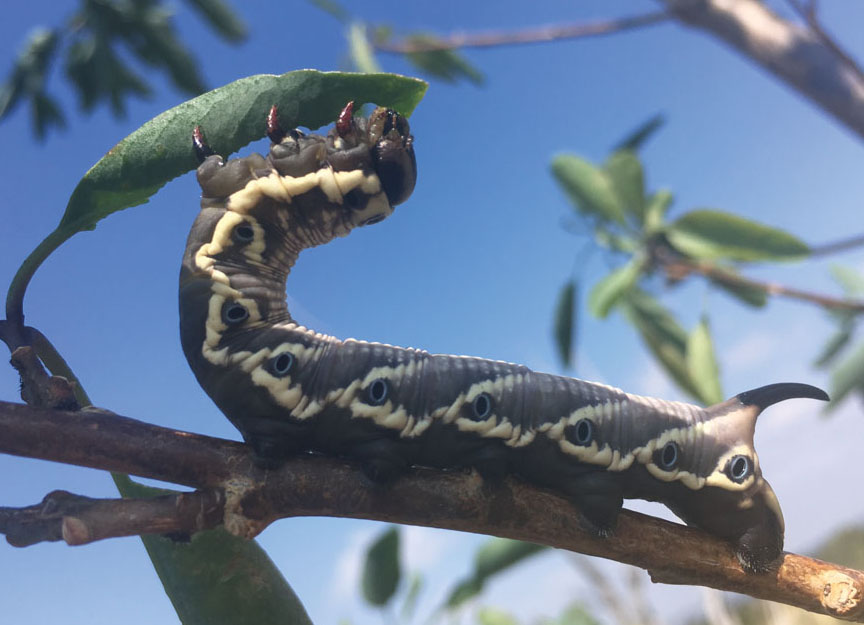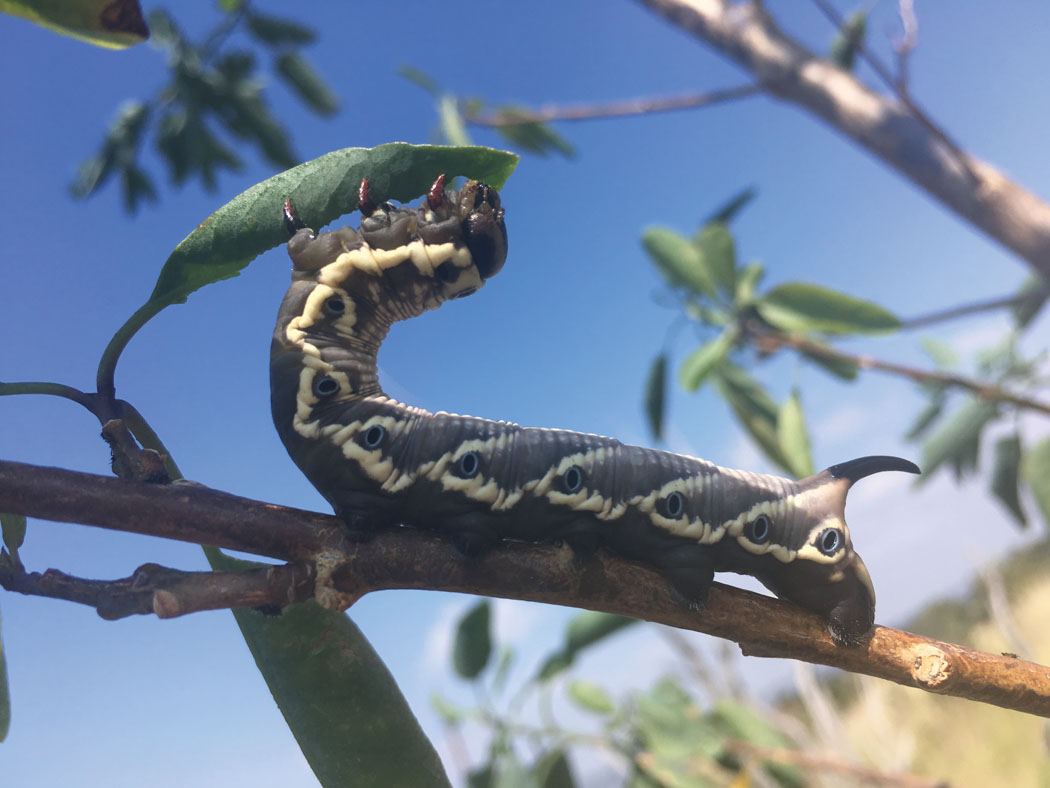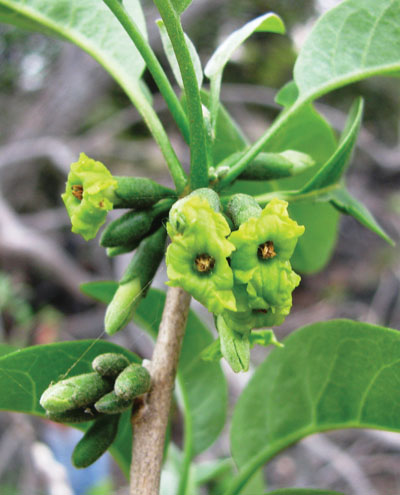
Malama Mokupuni—Caring for Our Island Environment: Invasive or Essential? A Rare Moth Depends on a Roadside Weed

By Rachel Laderman
A tiny shining orb on the underside of a leaf—is it the egg of an endangered, endemic moth? A team of volunteers systematically turns over every leaf on tree tobacco shrubs along a transect near Pu‘uwa‘awa‘a Forest Reserve. Christine Elliott, a University of Hawai‘i at Mānoa graduate student in entomology, leads the group in a yearly survey of Blackburn’s sphinx moth (Manduca blackburnii), ōka‘i in Hawaiian.

Christine comes over, looking optimistic, and peers at the perfect sphere. “Nope, that’s a water drop,” she tells the volunteer. “The eggs do look a lot like water drops, but not quite as shiny.” She pops it gently for proof. Soon after, another volunteer did find an egg, and really, it didn’t look that different!
From such a tiny drop of an egg, the caterpillar that grows is startlingly large. It resembles a tomato hornworm caterpillar, with a long, thick body and a threatening-looking, spine-like “horn.”
“Blackburn’s sphinx moth is Hawai‘i’s largest endemic insect,” Christine explains. The moth’s wingspan can reach five inches. “They were once abundant throughout Hawai‘i’s dry forests, but in the 1920s, started to dwindle. By the 1970s, they were thought to be extinct.” Then in 1984, a small population was rediscovered on east Maui, and later on two other islands, including here in Pu‘uwa‘awa‘a, on the slopes of Hualālai.
Part of the reason ōka‘i is so rare may be due to parasitoids and predators (which Christine is researching), but the overwhelming problem is the loss of healthy dryland forest habitat. As with many native animals, ōka‘i has a relationship with a native plant—the tree ‘aiea (Nothocestrum spp.).

‘Aiea is an endemic tree, only found in the Hawaiian Islands, with wonderful smelling flowers traditionally used in lei. Before timber cutting, ranching, and goats devastated the dry forests’ delicate ecology, three species of ‘aiea grew throughout the dry sides of the islands with a fourth species found in wet forests. Now all three dry forest species are endangered just like the ōka‘i they support.
Fortunately, the ōka‘i caterpillars can feed on other plants in the nightshade family, which includes tomatoes, tobacco, and the plant Christine’s groups survey—tree tobacco (Nicotiana glauca). Tree tobacco is a tall, spindly, non-native shrub that was introduced in Hawai‘i in the 1890s. Unfortunately, this ornamental, like so many others, has become an invasive weed.

“Tree tobacco invades gravel roads and can completely swallow them up, eventually making them undriveable,” notes Dr. Elliott Parsons, natural area reserves specialist with the Department of Land and Natural Resources (DLNR), who helps with the sphinx moth research.
“The fact that the Blackburn’s sphinx moth relies on an invasive species creates quite a conundrum,” says Christine. “People see tree tobacco and want to eradicate it, but the endemic species the moth relies on [‘aiea] is extremely rare and slow-growing.”

Kamahoi Hurley (Kama) is a volunteer who worked in Pu‘uwa‘awa‘a in 2015–16 as a Kupu intern, helping to save caterpillars from tree tobacco that was about to be removed because it was encroaching on roads.
“When we saw a caterpillar, we would carefully take it off and put it on another tree,” Kama said. “They were like 7–8 inches long, as big as a quarter in diameter. They try to bite or whip their tail and hit you with their horn!” He added, “Another defense mechanism is they vomit—the smell is pretty stink! And it sticks to your clothes!” Christine adds, “They fight back, that’s what I like about them. They’re plucky!”
A new threat to the Blackburn’s sphinx moth is the planned roadway additions to the Daniel K. Inouye Highway (Saddle Road). As the Environmental Impact Statement for the project states, “The endangered Blackburn’s sphinx moth could be harmed by construction and maintenance of a highway if the host plants used in its larval and pupal stages, or the ground immediately surrounding them, are disturbed.”
The reason that disturbing the ground nearby is an issue is because, after growing to a plump size feeding on tree tobacco leaves, the larvae (caterpillars) climb down from the shrubs and bury themselves in nearby soil, where they will eventually pupate. Sometimes they stay underground for up to a year.
This feisty, rare insect—just one of thousands of creatures unique to the Hawaiian Islands—focuses attention on a modern predicament: how do we manage a problematic, invasive species that also fills an important gap critical to the survival of endangered species? The answer isn’t obvious, but the more we can learn about the life cycle and habits of the species involved, the better decisions we can make. This explains why researchers and volunteers spend their days on sun-drenched slopes, determining if a tiny drop is just morning dew, or a rare egg clinging to survival.
To volunteer with Blackburn’s sphinx moth surveys at Pu‘uwa‘awa‘a State Forest Reserve, email napuuconservation@gmail.com. ❖
Rachel Laderman, Sustainable Pacific Program, Lynker LLC/NOAA Affiliate, Hawai‘i Island


